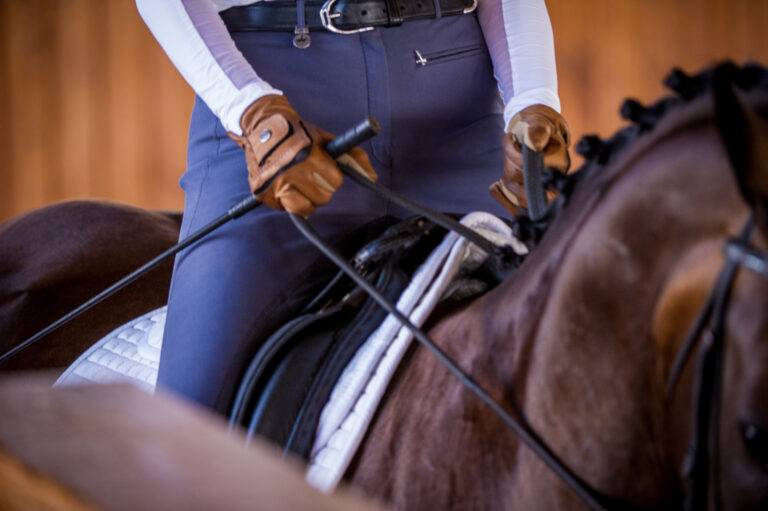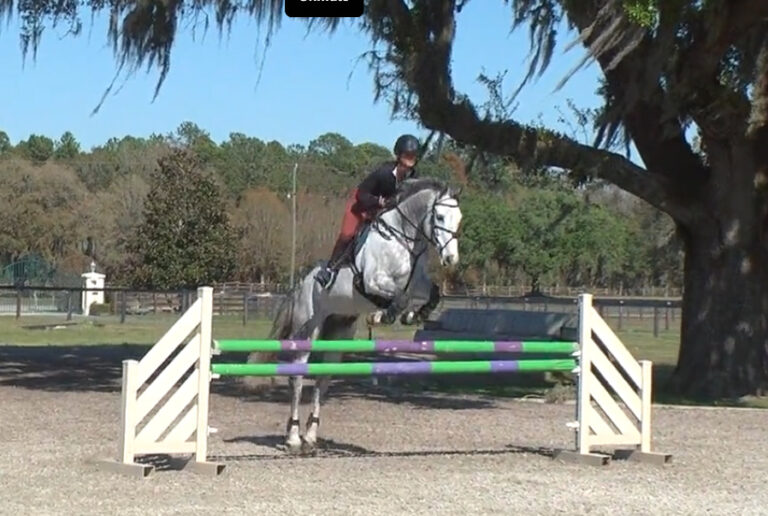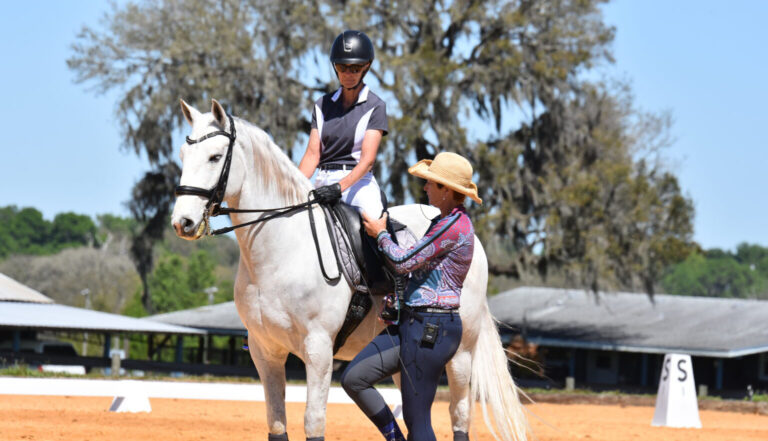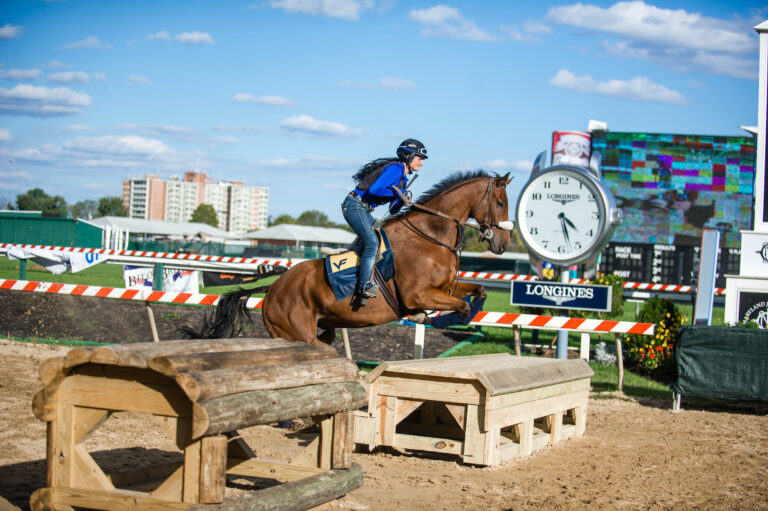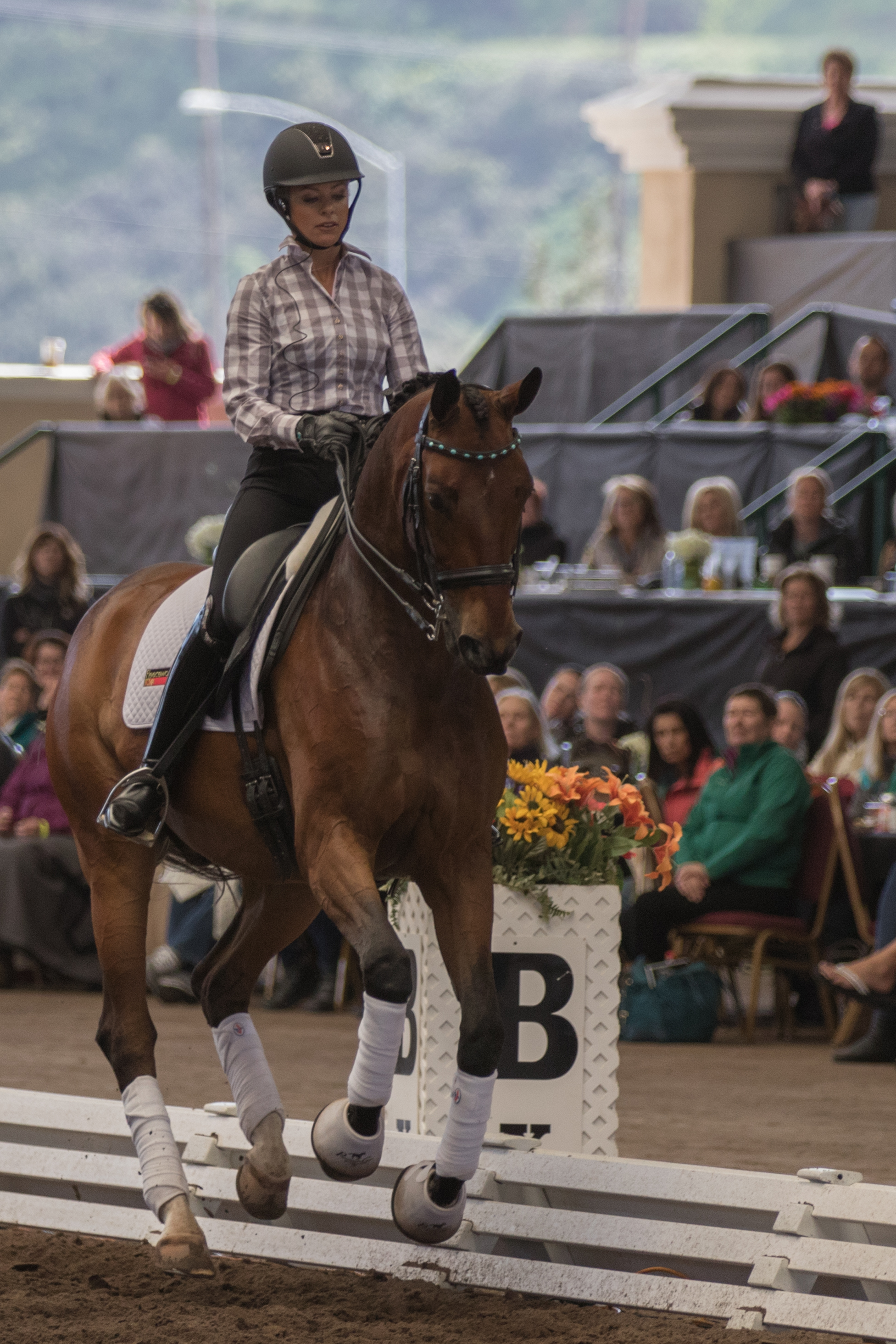
Five-time British Olympian Carl Hester revealed no secrets to success as he explained his approach to training horses during his first public clinic appearance in the United States. Dressage fundamentals rooted in the German Training Scale—rhythm, relaxation, contact, impulsion, straightness and collection—were the basis of every individual session he gave to 13 horse and rider pairs, whether it was two riders on 4-year-olds or his friend and fellow 1992 Barcelona Olympian Charlotte Bredahl-Baker on her nearly Grand Prix mount Hamilton.
The April clinic drew close to 3,000 equestrians to the Del Mar Fairgrounds in San Diego, California, home to many famous horse shows. Carl was the headliner of the West Coast Dressage Convention, organized by Vancouver special-event planner Scott Hayes Productions.
The youngest British rider to compete in the Olympics, the 1992 Games in Barcelona, at age 19, Carl helped Great Britain win its first Olympic dressage medal, a gold one, on its home turf in London in 2012. One week before his Del Mar trip, Carl rode Nip Tuck to a third-place finish in the 2017 FEI World Cup™ Dressage Final in Omaha, Nebraska.

Throughout his 30-plus years in the dressage world, Carl’s victories have paralleled his success bringing young horses up to the international stage, most famously the recently retired Valegro, along with his equally famous rider Charlotte Dujardin. Charlotte came up under Carl’s tutelage and is now his training partner at his yard in Gloucestershire County, England.
Carl’s riding resume is rivaled only by his low-key charisma and charm. Clinic spectators from all parts of the U.S. and Canada were excited to see the engaging and cheerful 50-year-old in person and soak up his expertise. They were treated to a weekend of education delivered with humor and a playful spirit and filled with self-effacing anecdotes about his journey getting to and staying at the top of the sport. At the end of each day, Carl had warm greetings for the long lines of autograph and photo seekers.
Auditors of all experience levels commented on the broadly applicable nature of Carl’s coaching. In that spirit, here are 14 tips culled from recurring themes throughout the weekend.
1. Every Transition Counts
Transitions between gaits were the foundation of most sessions and were taken seriously by Carl whether the rider was in the middle of an exercise or taking a break. “If you let the horse totally break down loose in a downward transition every time, that’s what he’ll do in the test.”
For a young horse, downward transitions were used to help build strength, develop balance and get him off the forehand. Don’t rush them, though. One rider was told to slow the tempo of her 4-year-old’s canter–trot transition so he “would have time to find his legs again.”
Transitions are excellent for schooling obedience or teaching the horse to work through his back. How many? Carl noted riders often did a handful every day and mistakenly considered that sufficient. He estimated that one rider in a 30-minute weekend session did about 100 and that was about right to address several training goals.
2. Give & Re-take
Riders at all levels were often told to make subtle, quick give-and-takes with the rein contact. Carl described the coming 4-year-old ridden by Joseph Newcomb as naturally well balanced in his gaits and already “light as a feather.” Working at the canter, Joseph was asked to give and re-take the reins to allow the youngster “the opportunity to balance himself.”
The give-and-re-take exercise helped teach or remind more experienced mounts to maintain their pace and self-carriage whenever “the button” was on for a specific gait. They shouldn’t slow down with a slight pick up of contact nor speed up with a slight release. Instead, the horse should learn to stay connected to your seat and remain the same until asked to do something different.
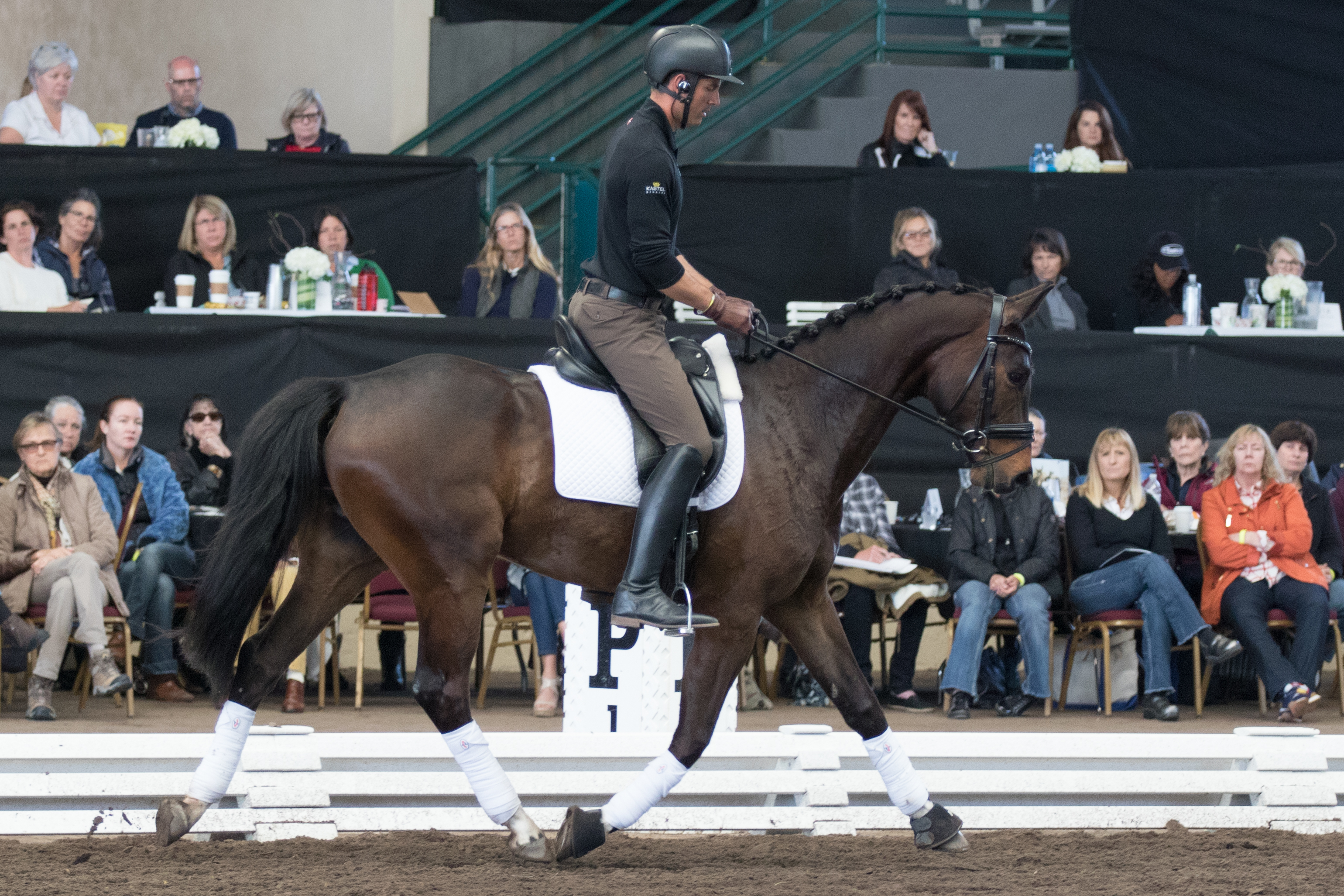
3. Go Forward
While Carl cautioned that forward without balance was not the goal, he explained that attempts to improve the hindquarter engagement that creates balance should “never confuse the go-forward cue or interfere with the forward response.” This came into play with Teri Patton Rich and Belissa, a 5-year-old. Like most well- trained horses at that age, the mare was ready to begin working on “the sit”—bringing her haunches underneath her body to push forward. Belissa’s strong conformation and high energy led to her trot being “too up and down,” Carl noted. “We want to work on genuinely going forward.”
Canter is the best gait for teaching the first steps of sitting, he explained, asking Teri to do a 20-meter circle with frequent half-halts to adjust her balance toward a lighter, lifted front end. When the mare broke to a trot at the half-halt cue, Carl insisted Teri resume the canter and keep going forward rather than stay with the trot or go down to the walk and start over. “The correction is an open door and this is all about getting her out in front of your leg.” Even if something goes badly and you want to do it over, maintain the forward for several strides before trying the half-halt again, Carl said.
4. Independent Seat
This trait is one of the biggest distinctions between good and great riders, Carl said. He especially recommended work without stirrups and at the canter for newer riders or those on a horse with an especially hard-to-sit trot. Off-the-horse work with physio balls or other core-strength exercises are also good. In his case, he credited growing up riding mostly bareback as his foundation for developing a seat that doesn’t rely on the horse’s mouth for balance or security.
“Magnet on hat and roof” was an image he used to help several riders lift their upper bodies, which also helped to elevate the horse’s front end and overall self-carriage. He told most to draw their belly buttons toward their spines at the same time. The first step to getting our horses in self-carriage is getting ourselves in self-carriage, he emphasized. Core strength is a big part of that.

5. Get Out of the Saddle
Carl had one rider alternate between standing in the stirrups and sitting in the saddle for several walk steps. The goal was to relax her seat and note the impact as her horse’s back and frame relaxed nicely in response. The simple exercise was suggested by a nonhorsey friend and is one that Carl said he now uses often.
Alternating a sitting and standing position in higher gaits is also a good test of whether the rider’s seat is constricting the horse’s stride.
Carl is a fan of rising trot in several situations. Its ability to free up the horse’s back makes it a good mode for work with young horses and extended gaits in horses of all ages. He encouraged riders to experiment with rising trot in lateral work, again because of the suppleness it facilitates in the horse’s back.
He had one rider use rising trot to work on passage. “You’ll get a slightly higher trot because you’ll draw him up with your upper body,” Carl explained. “It will help take the horse up and forward with you.” Rising trot can also help the horse establish and maintain the right rhythm.
6. Maintain a Forward Hand Position
Charlotte Dujardin’s oft-repeated quote, “Short reins win medals,” isn’t quite accurate, Carl said. “Where that came from was me telling her if your hand is not in front of the saddle it looks like you are riding backward,” he clarified. “If your hand is in front of the saddle, you will ride forward and get forward movements. So many ride with the reins too long and the horse falls through the bit. The forward hand will help you ride to the bit, not from the front to the back.”
7. Use the Arena
Carl advocates teaching and schooling flying changes along the rail to encourage straightness. “Give him the wall so he has to look after himself,” he told one rider whose upper-level mount swung his haunches from side to side in the tempi lead changes. Having a hoof touch the court rail or a schooling-ring wall is an effective lesson or reminder for the horse to keep himself straight rather than rely on the rider’s constant efforts to align the horse.
Carl also recommended the wall for teaching or schooling zigzags, a combination of two or more half-passes in opposite directions at the trot or canter. Compared to doing them from the centerline, anchoring them at the wall is an easier way to gauge that you are traveling an equal distance in both directions.
The short end of the arena is another great schooling aid, he said. Use it to get a feel for your horse’s stride length, especially the collected and regular canters. Depending on how much ground your horse’s stride covers, experiment with seven or eight strides across the short end. Then apply that information when determining where to start the lead changes in a diagonal line to fit evenly within the test’s specifications for where to start and finish.
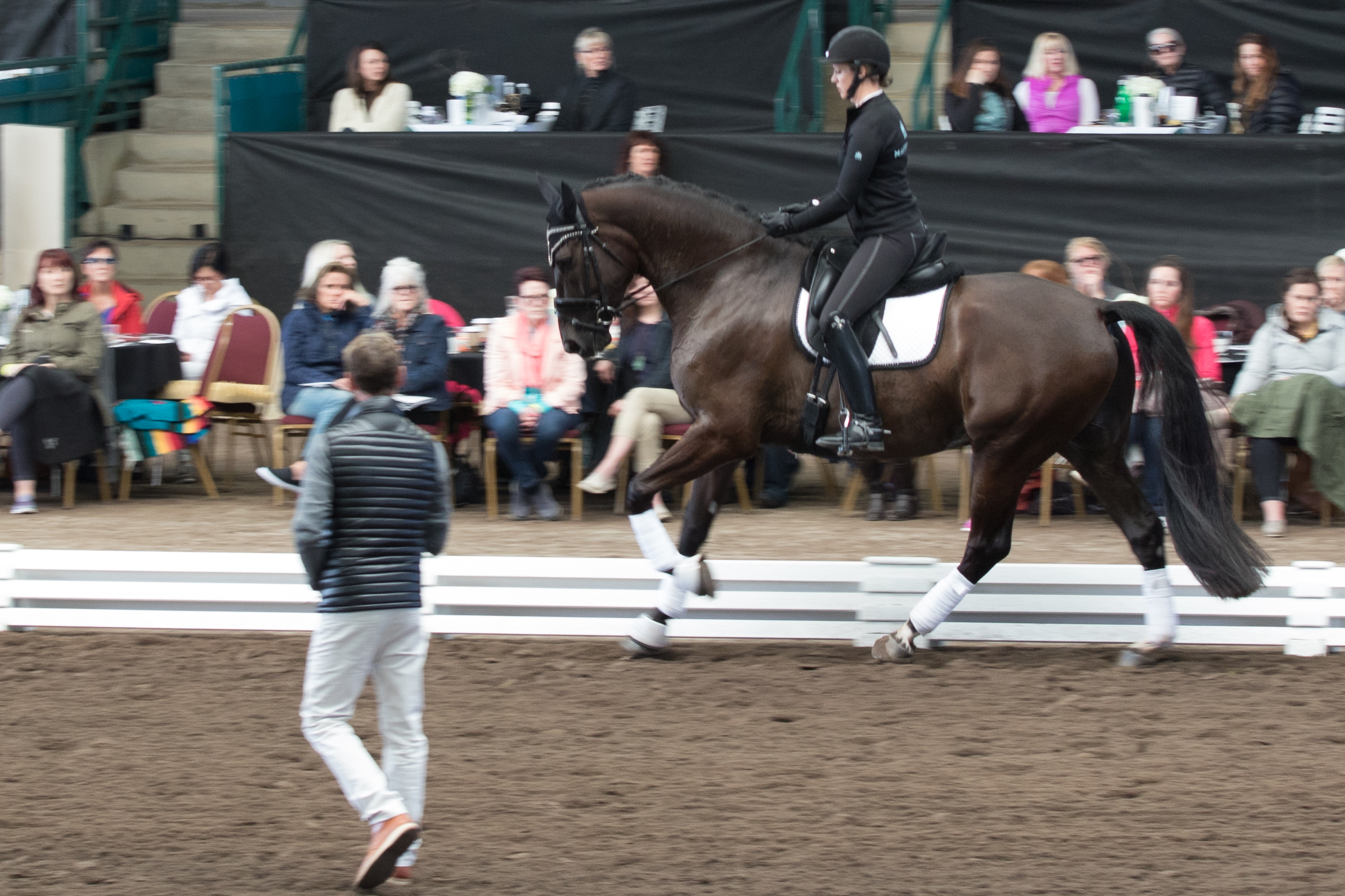
8. Make the Short End Your Friend
The short end, and even the corners going into and out of it, are typically where riders give up on whatever they were working on—often to good effect—on the long side. “We think no one will see us,” Carl shared of a tendency among riders at all levels. Riding a transition down to an active walk from the trot or canter through the short side was one exercise for developing the habit of maintaining focus on straightness, rhythm and engagement on that end.
9. Be Accurate
All dressage tests begin with riding down the centerline, then turning right or left. The pattern is also a good schooling tool to teach and reinforce straightness. In a test or schooling, the exercise involves riding straight down the centerline and then turning, Carl emphasized. It doesn’t mean riding straight toward the end of the ring, then preparing for the turn by drifting off the centerline in the opposite direction. That makes a very poor first impression in a test and defeats the straightness-schooling benefits of taking the proper track.
Accuracy is equally important at the highest levels. Pirouette strides, for example, should be evenly distributed on either side of the centerline. He pictures a clock face, with the horse’s front hooves coming down on 10 minutes past the hour, 20 past, half-past, all the way around.
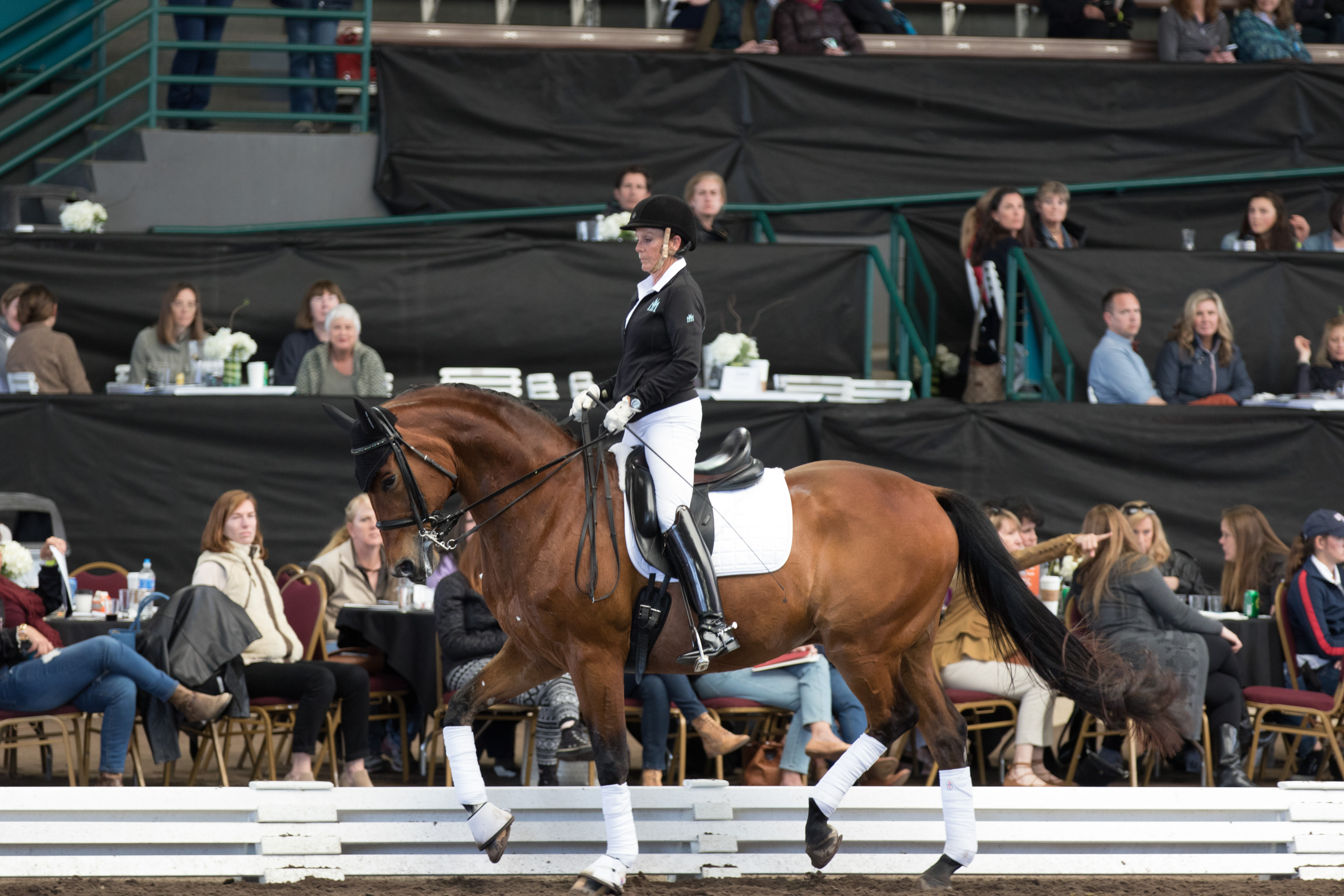
10. Gauge Your Horse’s Reaction to the Whip
“When you’re using a whip, it’s important to have the right reaction,” Carl explained. That is somewhere between the horse neither fearing it nor considering it his best friend. It should be used to get a quicker, brighter response to the leg and seat aid and must never be considered or used as a substitute for either.
Addressing a rider seeking more “jump” in her horse’s canter—in preparation for pirouette—Carl emphasized careful timing of the tap on the hindquarters. In this case, a light tap on the hindquarters timed with a slight rein release brought a nice forward response. However, the horse’s response to the collect cue needed more activity and better rhythm. “Collection is not slowing down,” Carl stressed. Working on a 20-meter circle at the canter, the rider was asked to make a “little touch” every two or three strides to help get the jump he wanted in collection. Half-halts were added approximately every 10 meters on the circle, reinforced with a “tick tick” of the whip again, to get that jump. The ultimate goal is for the tick of the whip to become a tick of the heel that generates the same quality of response.
11. Embrace Routine and the Great Outdoors
Carl’s horses spend a great deal of time outdoors and on the move, the latter being the biggest factor in maintaining soundness. It’s critical for creating looseness in the body and mind and a fantastic way to calm hot temperaments and keep veterans fresh in spirit.
Horses enjoy a regular work routine at Carl’s yard. On a weekly basis, schooling sessions rarely exceed 20 minutes and are preceded by warm-ups and followed by cool-downs that often consist of a hack down the road or through the fields.
Carl employs a two-days- on, one-day-off schedule. Giving the horses a day of purely conditioning work between their two consecutive learning days helps them retain new knowledge, he shared. Two days a week, the horses are simply hacked for fitness, often on surrounding hills, and the seventh day is for rest, much of it in pasture.
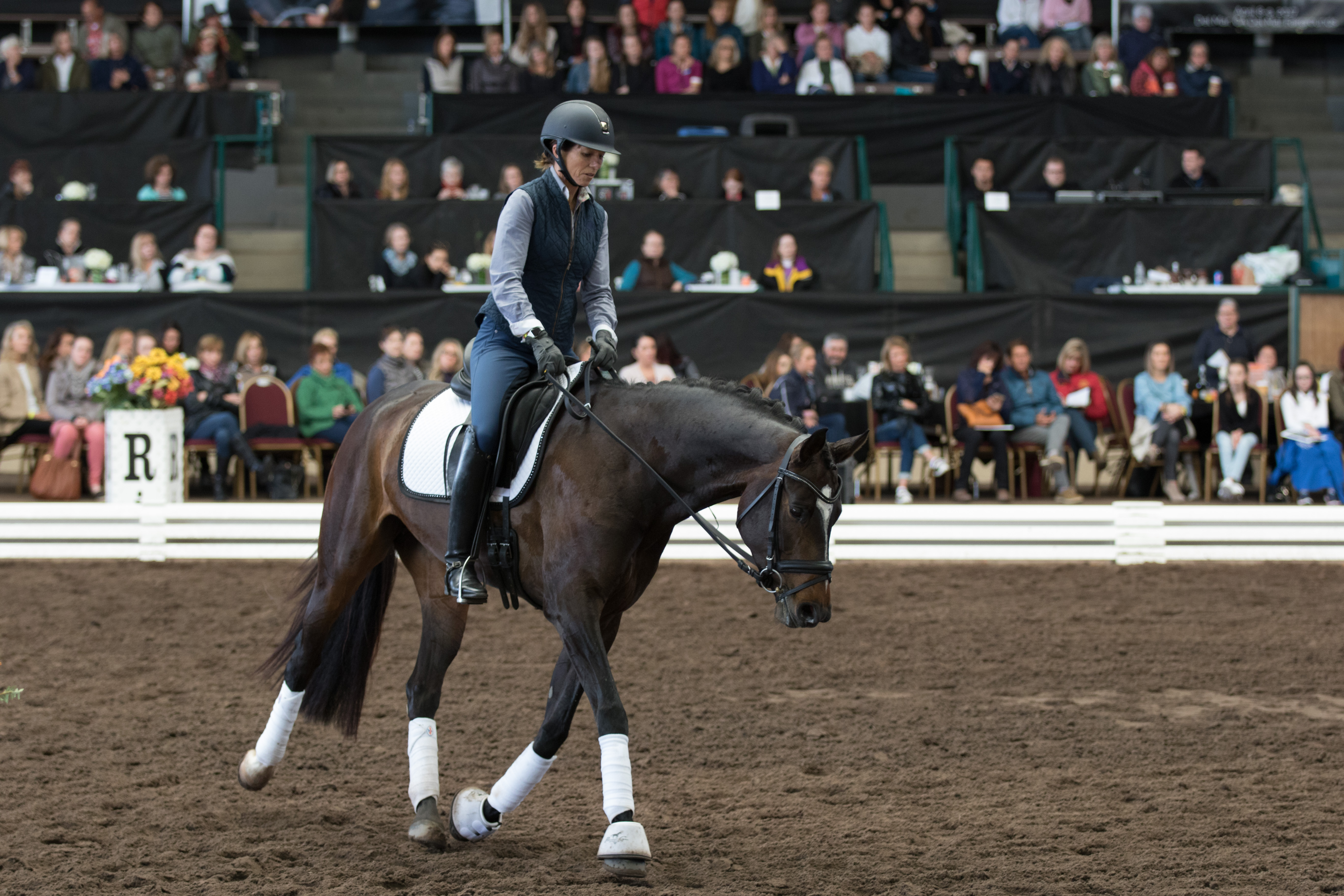
12. Don’t Over-Do Anything
Daily work should be structured into three parts with the intense learning phase sandwiched between long, loose periods of stretching and relaxation in warm-ups and cool-downs. Whatever the daily lesson, keep it brief and end on a high note by focusing on something the horse is already good at.
During warm-up and cool-down, the horse should be taught or encouraged to stretch his neck out and down without sacrificing a balanced frame. This evolves as the horse gets physically stronger and more educated.
13. About Anticipation
Carl acknowledged conflicting views on whether it’s good or bad for a horse to figure out what move the rider will ask for next. “I learned from Kyra [Kyrklund] that the horse should go to the corner and stop unless you’ve asked it to turn the corner,” he relayed. Over time, however, Carl recognized that “horses aren’t stupid, so anticipation shouldn’t be a dirty word.” Instead, riders need to find exercises that prevent that anticipation from squelching the quality of the next move without “squashing the horse’s spirit.”
One exercise to help find that right balance with anticipation entailed coming down to a halt at the end of the long side, then turning the horse into the rail through a turn on the forehand. Along with having the horse stand still before and after the turn, the exercise ensures he will stay tuned to his rider the next time he cruises toward a corner.
“With Valegro in the early days, I was very much about the horse not anticipating. We did a lot of exercises to make him wait. So in his first test we had this supremely talented horse who didn’t know what he was doing.” Carl switched to letting Valegro do his Grand Prix test once a week at home. “Then he did perfect tests. We always think we should not let the horse know the test, but in some cases, you want them to know because they’ll be more comfortable. Valegro is so smart, he was more comfortable when he got to do the test once a week.”
14. Be Brilliant
Don’t settle for simply doing the movement. Horses need to learn to do it with expression, and that starts with being willing to take a risk and make mistakes in schooling at home. Don’t rely on the electric atmosphere of the show ring to bring about quality that isn’t happening at home.
A student of dressage history, Carl noted how radically scores have risen over the years. “Great scores come from quality movements and riders who are willing to take a risk.”
For more details about what it was like to be at Carl Hester’s clinic, check out the July 2017 issue of our sister publication, Dressage Today.
This article was originally published in the July 2017 issue of Practical Horseman magazine.






